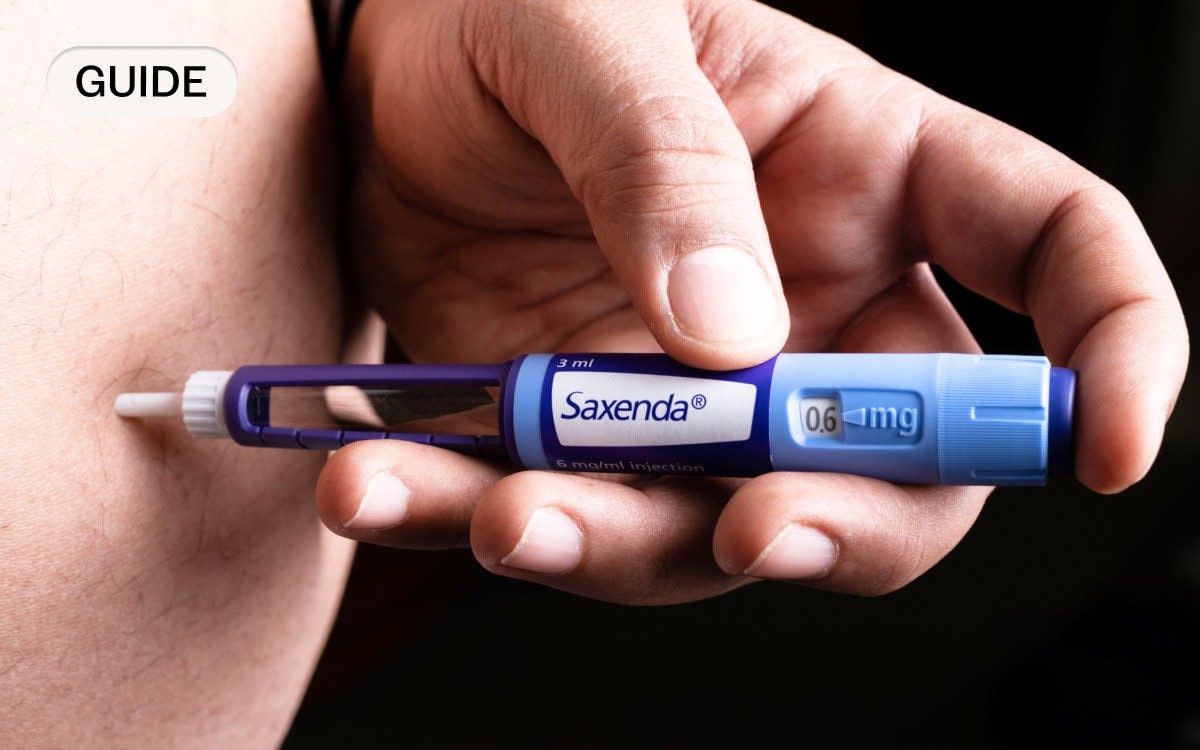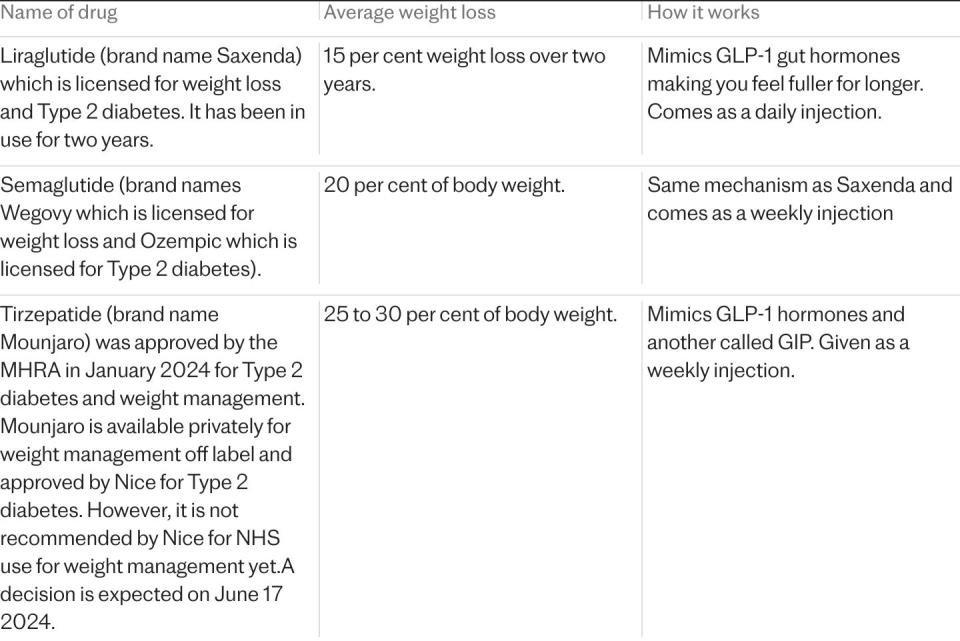Saxenda injections for weight loss: Side effects and benefits

Interest in the weight loss drug Saxenda has skyrocketed. According to Google Trends, searches have increased by a staggering 141 per cent over the past 12 months with many clamouring to get hold of the drug, but not all managing to due to worldwide shortages. So how exactly does this drug work, what are the drawbacks and how effective is it compared to other weight loss drugs?
Jump to:
What is Saxenda?
Saxenda is a form of prescription weight loss medication that contains an active ingredient called liraglutide. It comes in the form of an injection pen that you use once a day. Paired with increased daily exercise and a reduction in calories, Saxenda has been proven to aid weight loss. Along with Wegovy and Orlistat, and soon to be approved tirzepatide, they are the only drugs currently licensed in the UK for help uniquely with weight loss.
How does Saxenda work for weight loss?
“Saxenda works by mimicking the action of the hormone released by your gut in response to food; this includes a reduction of hunger and food intake, a reduction of satiation [the number of calories needed to reach fullness] as well as an increased level of fullness,” says Dr Henrik Gudbergsen, the chief medical officer at digital weight loss clinic Embla and an advisor to global healthcare companies.
Dr Sameer Sanghvi, a GP for Lloyds Pharmacy Online Doctor, one of the services prescribing Saxenda, warns that results can vary and that users should be realistic about their expectations.
“Saxenda is not a miracle weight loss aid and results won’t be immediate. Your weight loss will still rely on you maintaining a calorie deficit through a combination of physical activity and dietary changes. Plus, you will build up your Saxenda dosage over time. The full dose of the medication can give you side effects if you take it all at once, so the first four weeks are spent gradually building up to the full dose.
“It’s recommended that you try Saxenda for three months at the full dose. At this time, you should start to see results. You’ll be asked to recheck your weight and if you’ve lost enough weight you can continue with the treatment. Otherwise, you’ll need to stop.”
Potential side effects
Search data from SEO tool Semrush brings up an average 480 Google searches a month asking: “How safe is Saxenda?” This is a legitimate concern given the lengthy list of side effects for the drug.
Milder side effects include:
Belching
Constipation
Diarrhoea
Fatigue
Indigestion
Headaches
Heartburn
Nausea
Stomach cramps, discomfort or pain
Dry mouth
Vomiting
More serious side effects may include:
Bladder pain
Back pain
Bloody or cloudy urine
Blurred vision
Burning sensation when urinating
Dizziness
Fast heartbeat
Fever
Flu like symptoms including cough, sore throat, headache, sweating and shivering
Gall bladder problems
Hives or welts, itching or skin rash
Joint pain
Lumps in the neck
Pain or inflammation around the injection site
Pancreatitis
Seizures
Swelling of the face, eyelids, lips, tongue, hands, feet or genitals
Dr Intkhab Raja, a GP, worries that societal pressures to achieve quick and dramatic weight loss results are leading to a trend for people to seek out quick and dramatic weight loss results illegally.
“Saxenda, a prescription medication, is perceived as a quick fix, leading some to obtain it without proper medical supervision,” he warns. “However, the risk of side effects is very real. Dangers include severe allergic reactions which may manifest as difficulty breathing, swelling and rashes. Saxenda may increase the risk of developing pancreatitis, characterised by severe abdominal pain. Additionally, Saxenda has been associated with an increased risk of thyroid tumours, including cancer.”
Safe dosage for Saxenda injections
Saxenda is self-injected using the pen provided, once daily at any time of the day or night and with or without food. Dr Sanghvi advises that you should inject it “under the skin in either the stomach area, upper arm or upper leg. You should also rotate the injection site to avoid getting lumps under the skin”.
The dosing schedule for Saxenda, as endorsed by the brand itself, is as below. Users gradually increase the dosage, checking as they go along that they are not experiencing ill-effects, until they reach the maximum dose of 3.0mg.

Comparison with other weight management drugs
Besides Saxenda, Wegovy and Orlistat are the only medications that are licensed and approved for weight loss in the UK.
Orlistat is an oral medication rather than an injectable and works differently from Saxenda and Wegovy in that it is a lipase inhibitor. It prevents around a third of the fat in foods eaten from being absorbed by the intestines and allows it to instead be expelled in faeces. Due to its mechanism of action, uncomfortable side effects include urgent bowel movements and oily stools.
Wegovy on the other hand is a brand name for semaglutide which works in the same way as Saxenda, by mimicking the GLP-1 hormone, targeting the areas of the brain that regulate appetite, helping you feel full and therefore aiding weight loss.
Ozempic, which also uses semaglutide as the active ingredient, is developed and designed for patients with Type 2 diabetes. However, it was shown to be very effective at aiding weight loss and so Wegovy was developed specifically to be prescribed for weight loss.

According to Dr Gudbergson, there are medical pros and cons for semaglutide and liraglutide: “While common side effects of both drugs include nausea, vomiting, diarrhoea and constipation, both types of medications may offer cardiovascular benefits, including improved blood pressure and cholesterol levels and a reduction of cardiovascular events such as heart attack. They may also lead to a reduction in inflammatory markers as well as an improvement in glycemic control.
“Long-term safety data is more established for liraglutide than for semaglutide, but both have demonstrated acceptable safety profiles in clinical studies.”
In fact, in randomised clinical trials, semaglutide was shown to be more effective, reducing weight by over 15 per cent whilst liraglutide reduced weight by around 6 per cent. Anecdotally, many users report that semaglutide medications such as Wegovy are better tolerated by the body than liraglutide medications, such as Saxenda. Only 13.5 per cent of participants in the semaglutide group stopped their treatment because of side effects, compared with 27.6 per cent of the people taking liraglutide.
Cost and availability in the UK
The NHS will only prescribe Saxenda if: you have a BMI of over 35 (or 32.5 if you’re of south Asian, Chinese, black African or African-Caribbean origin); you have non-diabetic hyperglycemia; and you’re at high risk of heart problems, such as heart attacks or strokes.
NHS GPs do not prescribe Saxenda or other weight loss drugs directly, but can refer you to a specialist Tier 3 Weight Management Service if you have a BMI of over 35 and a co-morbidity such as heart disease. Many people will therefore not qualify for free NHS prescriptions and will have to attend a private clinic.
Saxenda costs around £51 for one pen and you’ll typically need five pens per month when you’ve gone through the titration process. With Lloyds Pharmacy Online Doctor’s Saxenda service for example, the three-pen starter pack costs £149. After that, five-pen maintenance packs cost £239. Each pack will last a month.
By means of comparison, Wegovy pens start at £149, with the cost increasing to around £160 as the doses get higher. However, each pen has enough for four doses which will last you four weeks.
The main issue with Saxenda, however, is with limited availability.
Could Saxenda work for you? The expert consensus
“Medication alone is not the answer for effective weight loss,” says Dr Gudbergsen. “Weight loss is complicated, because people are. It’s tied to genetics, personality, lifestyle, hormones, habits, relationships and psychology, and requires multiple personalised interventions across nutrition, mental health, movement and psychology. In fact, Embla’s latest study (presented at the European Congress on Obesity 2024), found that lower doses of weight loss drugs are as effective as higher ones when paired with coaching, and patients who tapered off the drug while focusing on lifestyle changes, kept off lost weight for at least six months.”

 Yahoo News
Yahoo News 